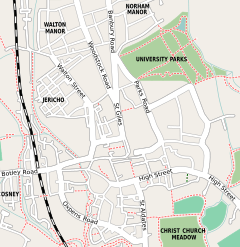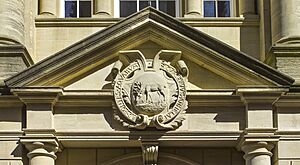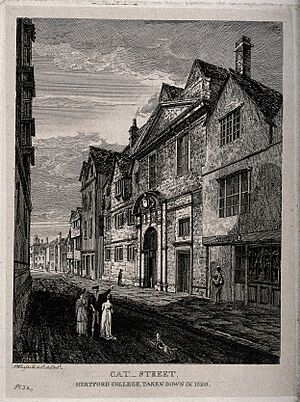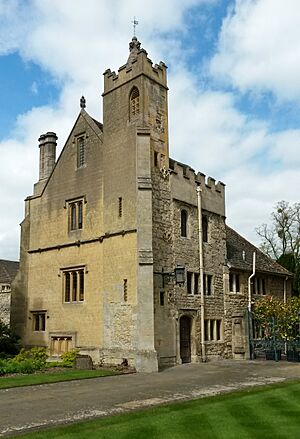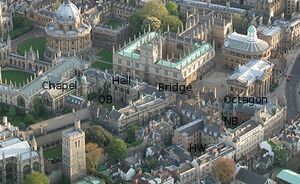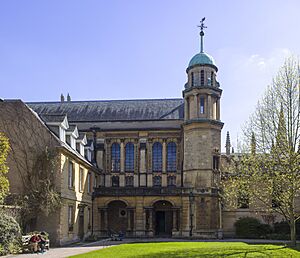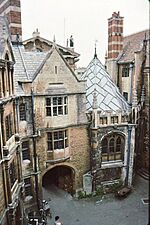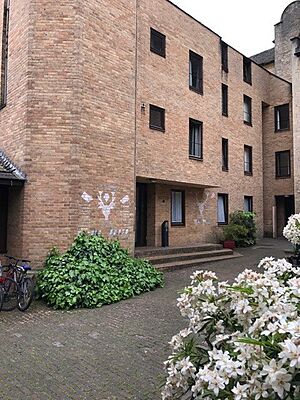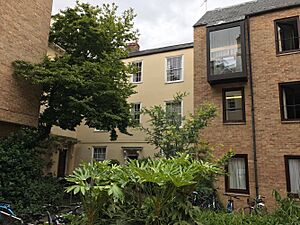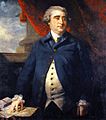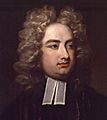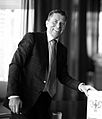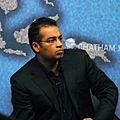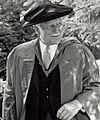Hertford College, Oxford facts for kids
Quick facts for kids Hertford College |
||||||||||||||
|---|---|---|---|---|---|---|---|---|---|---|---|---|---|---|
 |
||||||||||||||
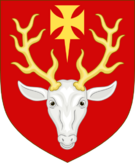
Blazon: Gules, a hart's head cabossed argent, attired and between the attire a cross patty Or, fitched in the foot
|
||||||||||||||
|
|
||||||||||||||
| University | University of Oxford | |||||||||||||
| Location | Catte Street, Oxford OX1 3BW | |||||||||||||
| Coordinates | 51°45′15″N 1°15′12″W / 51.754205°N 1.253467°W | |||||||||||||
| Full name | Hertford College in the University of Oxford | |||||||||||||
| Latin name | Collegium Hertfordiense | |||||||||||||
| Motto | Sicut cervus anhelat ad fontes aquarum (Latin) | |||||||||||||
| Motto in English | As the hart panteth after the water brooks | |||||||||||||
| Established | 1282 (as Hart Hall) 1490 (as Magdalen Hall) 1740 and 1874 (as Hertford College) |
|||||||||||||
| Named for | Elias de Hertford | |||||||||||||
| Sister college | None | |||||||||||||
| Principal | Tom Fletcher | |||||||||||||
| Undergraduates | 403 (2017/2018) | |||||||||||||
| Postgraduates | 222 | |||||||||||||
| Grace | Benedictus benedicat May the Blessed One bless Benedicto benedicatur May the Blessed One be blessed |
|||||||||||||
| Boat club | Hertford College Boat Club | |||||||||||||
| Map | ||||||||||||||
Hertford College (pronounced HART-fərd), once called Magdalen Hall, is a part of the University of Oxford in England. It is in the center of Oxford on Catte Street, right across from the main entrance to the Bodleian Library. The college is famous for its beautiful bridge, the Bridge of Sighs.
About 600 students study at Hertford College. This includes undergraduate students, graduate students, and visiting students from other countries. The college first started in the 1280s as Hart Hall. It became a college in 1740 but closed in 1816. In 1820, Magdalen Hall moved to the site. Magdalen Hall had started around 1490. In 1874, Magdalen Hall officially became a college again, taking back the name Hertford College. In 1974, Hertford was one of the first all-male Oxford colleges to welcome women students.
Many famous people have studied here. They include William Tyndale, who translated the Bible, and the writer John Donne. Later students include author Evelyn Waugh and Jacqui Smith, who was the first female Home Secretary.
Contents
The Early Years: Hart Hall and First Hertford College
Hart Hall's Beginnings
Hertford College began as Hart Hall (Aula Cervina) in the 1280s. It was a small building where the college's Old Hall is today. In medieval Oxford, "academic halls" were mainly places for students and tutors to live.
The first building was bought by Elias de Hertford in 1283. He sold it to John de Dokelynton in 1301. The hall's name likely came from Elias's hometown, Hertford. This also allowed the college to use a hart (a male deer) as its symbol.
In 1312, John of Ducklington sold Hart Hall to Walter de Stapledon, the Bishop of Exeter. He wanted to start a college. After a year, Stapledon moved his students to a larger site. This became Exeter College. However, Exeter College kept some rights over Hart Hall for many years.
In 1379, William of Wykeham rented Hart Hall. It was a temporary home for his students while his New College was being built. By the 16th century, Hart Hall had grown. It took over nearby halls like Black Hall and Cat Hall. This gave Hart Hall most of the land where its Old Quadrangle is now.
In the late 1500s, Hart Hall became a place for Catholic students. This was especially true under Principal Philip Randell. The poet John Donne came to Hart Hall in 1584.
Hart Hall continued to grow, and new buildings were added. In the early 1600s, the current Senior Common Room was built. The main entrance moved from a small passage to a gate on Catte Street. In the late 1600s, Principal William Thornton added a proper gate. It had a drinking hart and the motto: Sicut cervus anhelat ad fontes aquarum. This means "As the hart panteth after the water brooks." This motto is from Psalm 42. The current gatehouse still has this design and motto.
In 1692, the writer Jonathan Swift joined Hart Hall to get his Master's degree.
Richard Newton's Hertford College
In 1710, Richard Newton became the principal of Hart Hall. He was an energetic reformer. Newton worked hard to pay off the hall's debts and get more money for it. He planned to rebuild the hall around a square courtyard. But only two buildings from his plan were ever built. These were the Cottage and a simple stone Chapel. The Chapel was built in 1716 and is now the college's Library. Newton paid for these buildings himself.
In 1720, Newton wrote about his education plan. He wanted the hall to become a proper college. But his idea faced a lot of opposition. After many years, his plans were accepted. On September 8, 1740, Hart Hall officially became "Hertford College."
Newton's Hertford College was quite simple. Meals were cheap, and students were expected to work hard. Newton made sure that even wealthy students followed the same rules. This meant many families sent their sons to Hertford for a disciplined education.
Decline and Closure
After Richard Newton died in 1753, the college struggled. Most principals after him did not have his energy. One exception was David Durell, who improved the college's reputation. Under Durell, the future statesman Charles James Fox studied there in 1764.
However, the college slowly declined. This was due to poor management and a lack of money. In 1805, the last principal of Hertford College died. No one could agree on a new leader. By 1810, no new students were joining. In May 1816, a group decided that Hertford College should close.
Magdalen Hall and the Second Hertford College
Magdalen Hall's History
Magdalen Hall started around 1490. It was next to Magdalen College and its grammar school. This area is now Magdalen's St Swithun's quadrangle. The hall quickly became an independent school.
Magdalen Hall was known for following the ideas of John Wycliffe. William Tyndale, who translated the English Bible, studied there. Another famous student was the philosopher Thomas Hobbes, who came in the early 1600s. During the English Civil War, Magdalen Hall was known as a Puritan school.
When the first Hertford College closed, Magdalen College wanted to expand. They planned for Magdalen Hall to move to the Hertford College site. Today, Hertford College's Lodge still shows the symbols of Magdalen Hall and Magdalen College.
Moving to Catte Street
John Macbride became the principal of Magdalen Hall in 1813. Plans to move the hall to the Hertford College site were already in motion. In 1815, Magdalen College suggested the move. They offered to fix the Hertford buildings and pay for the move. In return, Magdalen Hall would give up its old buildings.
An Act of Parliament supported the plan. But the move didn't happen until a fire in 1820 destroyed half of Magdalen Hall's buildings. Soon after, one of Hertford College's buildings on Catte Street also collapsed. With this push, the new Magdalen Hall began construction on May 3, 1820. The hall finished moving by 1822. The Catte Street front was rebuilt, and some buildings got an extra floor.
Magdalen Hall grew to be the largest hall. Macbride tried to change the name to "Magdalene Hall," but it was never accepted. Macbride was principal for 54 years until he died in 1868.
Hertford College Reborn
During John Macbride's time, it became clear that Magdalen Hall should become a college. Since "Magdalen College" was already taken, they decided to bring back the name "Hertford College."
Richard Michell became principal in 1868. He brought a bill to Parliament in 1873 to make Magdalen Hall Hertford College. Thomas Charles Baring gave a lot of money to support this. On August 7, 1874, Magdalen Hall officially became "Hertford College." Michell was the last principal of Magdalen Hall and the first of the new Hertford College.
Baring bought a house for fellows across New College Lane. This was the college's first step onto the north side of the lane. Other houses were bought, and the old Chapel of Our Lady at Smithgate became the Octagon. A new gatehouse was built on Catte Street, and a new dining hall was built above it.
In 1877, Henry Boyd became the second principal of the new Hertford College. His energy helped create the modern college we see today. Boyd's name is carved on the famous Bridge of Sighs. He also has a memorial in the Chapel. Boyd worked with architect Thomas Graham Jackson. Jackson designed the Gatehouse, the Hall, and its spiral staircase. In 1901, Jackson started building on the north side of New College Lane. By 1908, he finished a new Chapel. In 1913, he built the Bridge of Sighs, connecting the Old and New Quads.
During the two world wars, 171 Hertford College members died. They are remembered with memorials in the Chapel.
In 1922, the novelist Evelyn Waugh studied at Hertford. He wrote about his time at Oxford in his book Brideshead Revisited.
Starting in 1965, Hertford tried to encourage students from public schools. This was called the Hertford Scheme. It helped raise academic standards at the college. Today, about 70% of undergraduate students come from UK public schools. Hertford also welcomed the first African-American Rhodes Scholar, Alain Leroy Locke, in 1907. Other colleges had refused him.
Geoffrey Warnock was principal from 1971 to 1988. In 1974, Hertford became one of the first five colleges to admit both men and women. Today, the college has a nearly equal number of male and female students. A student housing building is named Warnock House in his memory.
College Buildings
Hertford College's main site is on Catte Street, New College Lane, and Holywell Street. It has three main courtyards: Old Quadrangle, New Quadrangle, and Holywell Quadrangle. The college also has student housing near Folly Bridge.
Old Quadrangle
The Old Quadrangle (or Old Quad) is the oldest part of the college. You enter it through the Gatehouse on Catte Street. The Gatehouse was built in the late 1800s. It has a carving of a drinking hart above the archway. The wooden doors are the original gates from Hart Hall in the 1600s.
Inside, the quadrangle has a nice lawn and some trees. Students can sit on the lawn in the summer term.
In the north-east corner is the Old Hall. This is the oldest building from Hart Hall, dating back to the 1570s. It is now used for dining. Along the eastern side is a 17th-century building. It used to be student rooms and the principal's home. Today, it mostly holds the Senior Common Room. The Old Library is also in this building. In the south-east corner is the Cottage, built in the 1700s.
The southern side of the quad has the Chapel, built in 1908. It has great acoustics for music. Its front area has a stained-glass window of William Tyndale. West of the Chapel is the Library. This building was the college's chapel in the 1700s. The Library has many old books, including a first edition of Thomas Hobbes's Leviathan.
The western side has the Gatehouse and the Lodge. The Principal's Lodgings are also here. The north-west building connects to the Bridge of Sighs. Above the Gatehouse is the dining Hall. It has wood panels and college portraits. You reach the hall by a unique stone spiral staircase.
The northern side of the quad has a building that now holds the Bursary (college office).
New Quadrangle
The New Quadrangle (or New Quad) connects to the Old Quad by the Bridge of Sighs. Most of the New Buildings were designed in the early 1900s. The quad is entered through a gate on Catte Street. New Quad is mainly used for student housing.
The most important building here is the Octagon. It holds the Middle Common Room. This building was once the 16th-century Chapel of St Mary the Virgin at Smithgate.
Holywell Quadrangle
Holywell Quadrangle is right behind New Quad. They are connected by a hallway. Holywell Quad was built in 1975. It is mostly for first-year students. It has a gate onto Holywell Street and the Junior Common Room. The Baring Room, named after a major helper of the college, is also here.
Student Life
Undergraduate students can live in college housing for all their years of study. This is either on the main site or in other college buildings. A new Hertford Graduate Centre for graduate students opened in 2000.
Hertford has a college cat named Simpkin. He lives in the Lodge. Simpkin is the fourth cat with this name. Alumni donate money to cover his food and vet bills.
Academic Success
Hertford's exam results are usually above average. In recent years, it has ranked well among Oxford colleges.
Sports

The Hertford College Boat Club is one of the best Oxford college boat clubs. Both its women's and men's first boats are in the top division. Their boats and club room are at the Longbridges boathouse. In 1881, the college's boat team won "Head of the River" in the annual college boat races. They carried their boat back to the college and burned it to celebrate!
In 2005, the boathouse was burned down by the Animal Liberation Front. This was a protest against animal testing at the university. A new boathouse was built in its place.
The college got a new gym in 2011. It also has playing fields for team sports. In 2013, the Hertford College Rugby Club was the first UK team to tour Mongolia. They played matches that were broadcast live on Mongolian TV.
Music
Hertford College has the biggest and most active music society at Oxford. Musicians from all over the university join. Groups include the Hertford College Orchestra and the Chapel Choir. The Chapel's great sound makes it a popular place for concerts and recordings.
People Connected to the College
Principals
The current Principal of Hertford College is Tom Fletcher. He became principal in 2020. He was previously the UK Ambassador to Lebanon.
Current Teachers and Professors
The college has over 30 teachers and professors. They teach subjects offered to undergraduate students. Some of them include:
- Hagan Bayley, Professor of Chemical Biology
- Charlotte Brewer, Professor of English Language and Literature
- Dame Kay Davies, Professor of Anatomy
- Martin C. J. Maiden, Professor of Molecular Epidemiology
- Ian McBride, Professor of Irish History
- Peter Millican, Professor of Philosophy
- Christopher J. Schofield, Professor of Organic Chemistry
- Emma J. Smith, Professor of Shakespeare Studies
- David Ian Stuart, Professor of Structural Biology
- David Thomas, Professor of Geography
- Claire Vallance, Professor of Physical Chemistry
- Michael Wooldridge, Professor of Computer Science
- Alison Woollard, Associate Professor in Genetics
Retired Professors
The college has many retired professors, called Emeritus Fellows. They include:
- Toby Barnard, historian
- Martin Biddle, archaeologist
- Robin Devenish, former Professor of Physics
- Fionn Dunne, former Dean and Fellow in Engineering
- Bill MacMillan, former Pro-Vice-Chancellor
- Tom Paulin, former Lecturer in English
- Christopher Tyerman, former Professor of History of the Crusades
- Alison Young, former Professor of Public Law
Honorary Fellows
Honorary Fellows are people who have achieved great things and have a special connection to the college. Some of them are:
- John Baring, 7th Baron Ashburton
- Walter Bodmer, former principal
- Martin Bridson, mathematician
- Nancee Oku Bright, documentary filmmaker
- Sherard Cowper-Coles
- John Dewar, former Tutor in Law
- Richard W. Fisher, ambassador
- R. F. Foster, historian
- Andrew Goudie, Master of St Cross College
- Charlotte Hogg, economist
- Will Hutton, economist and former Principal
- The Very Reverend Jeffrey John, Dean of St Albans
- Sir Jeffrey Jowell QC, barrister
- Soweto Kinch, jazz musician and rapper
- John Landers, former principal
- Paul Manduca, chairman of Prudential plc
- The Rt. Rev. Thomas McMahon, Catholic Bishop
- Paul Muldoon, President of the Poetry Society
- David Pannick, Baron Pannick
- Mary Robinson, former President of Ireland
- Jacqui Smith, former Home Secretary
- Stephanie West, classical scholar
- General Roger Wheeler, former Chief of the General Staff
- Athol Williams, poet and applied philosopher
- Tobias Wolff, author
Famous Former Students
From Hart Hall and the First Hertford College (1282–1816)
From Magdalen Hall (1480–1874)
From the Second Hertford College (1874–present)
See also
 In Spanish: Hertford College para niños
In Spanish: Hertford College para niños


